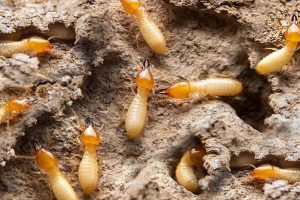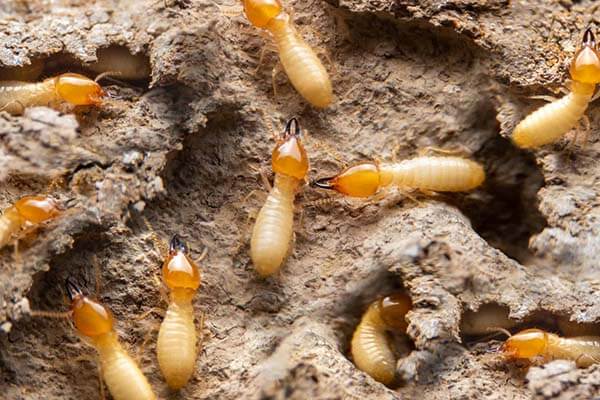Termites
termite, (order Isoptera), any of a group of cellulose-eating insects, the social system of which shows remarkable parallels with those of ants and bees, although it has evolved independently.
Even though termites are not closely related to ants, they are sometimes referred to as white ants. Phylogenetic studies have shown that the closest relative to the termite is the cockroach; for this reason termites are sometimes placed in the order Dictyoptera, which also contains the mantids.

Termites pest control near me in nairobi kenya
General features of Termites
Termites Distribution and abundance
Learn how termites use salivary secretions to cement debris to decaying wood nests in their rainforest habitat
Learn how termites use salivary secretions to cement debris to decaying wood nests in their rainforest habitatSee all videos for this article
Termites, which number about 2,750 species, are distributed widely, reaching their greatest abundance in numbers and species in tropical rainforests around the world (see video).
In North America termites are found as far north as Vancouver, British Columbia (Zootermopsis), on the Pacific coast, and Maine and eastern Canada (Reticulitermes) on the Atlantic coast.
In Europe the northern limit of natural distribution is reached by Reticulitermes lucifugus on the Atlantic coast of France, although an introduced species, Reticulitermes flavipes, occurs as far north as Hamburg, Germany.
The known European species of termites have a predominantly Mediterranean distribution and do not occur naturally in Great Britain, Scandinavia, Switzerland, Germany, or northern Russia.
In the Far East Reticulitermes speratus ranges as far north as South Korea, Peking, and northern Japan. Termites occur also in the Cape region of South Africa, Australia, Tasmania, and New Zealand.
In addition to naturally occurring termites, many species have been inadvertently transported by humans from their native habitats to new parts of the world. Termites, particularly Cryptotermes and Coptotermes, have been accidentally transported in wooden articles such as shipping crates, boat timbers, lumber, and furniture.
Because dry-wood termites (e.g., Cryptotermes species) live in small colonies in wood and tolerate long periods of dryness, they can survive in seasoned wood and furniture and can easily be transported over long distances.
Members of the family Rhinotermitidae (e.g., Coptotermes) require access to moisture and cannot survive prolonged dry periods.
Coptotermes formosanus, widely distributed in Japan, Taiwan, and South China, has been introduced into Sri Lanka (Ceylon), the Pacific islands, South Africa, East Africa, Hawaii, California, and the southern United States. C. formosanus is unusual for the family in that it can survive without direct soil contact as long as a moisture source is present.
In the United States the species has been found to have well-established colonies in the upper reaches of buildings, using small leaks in the roof as a moisture source.
A termite native to the United States, Reticulitermes flavipes, was found in the hothouses of the Royal Palace in Schönbrunn, in Vienna, and the species was reported and described in that location before it was discovered in the United States.
The termites presumably had been shipped from North America in wooden containers of decorative potted plants.
Importance of Termites
Termites are important in two ways. They are destructive when they feed upon, and often destroy, wooden structures or vegetable matter valuable to humans. Introduced species, because they are not so well equipped as native species to adapt to changes in their new environments, tend to seek shelter in protected, man-made environments such as buildings and thus are likely to become the most serious pests, causing significant damage to houses and wooden furnishings.
Some termites feed on living plant materials and can become serious crop pests. Termites are also extremely beneficial in that they help to convert plant cellulose into substances that can be recycled into the ecosystem to support new growth.
1. Eliminate wood in contact with the ground. Termite problems often occur when wood components of the building are in direct contact with soil. Earth-to-wood contact affords termites’ easy access to food, moisture and shelter, and direct, hidden entry into the building. Wood siding, door and window frames, etc. should be at least six inches above ground level.
Eliminating wood-to-soil contact may require regrading or pulling soil or mulch back from the foundation, cutting the bottom off wood latticework, or supporting steps or posts on a concrete base. Posts or stairs embedded in concrete are also vulnerable to termite attack since they usually extend all the way through the concrete to the soil. Contrary to popular belief, pressure-treated wood is still vulnerable to termite attack; termites often enter the wood through cracks and cut ends, or build tunnels over the surface.
2. Do not let moisture accumulate near the foundation. Termites are attracted to moisture and are more likely to infest if the soil next to the foundation is consistently moist. Water should be diverted away with properly functioning gutters, downspouts and splash blocks.
Leaking faucets, pipes and air conditioning units should be repaired, and the ground next to the foundation should be graded (sloped) so that surface water drains away from the building. Homes with poor drainage may need to have tiles or drains installed. Lawn sprinklers and irrigation systems should be oriented to minimize water puddling near the foundation.
3. Reduce moisture and humidity in crawl spaces. Most building codes call for one square foot of vent opening per 150 square feet of crawlspace area. For crawlspaces equipped with a vapor barrier (see below), the total vent area often can be reduced to one square foot per 300 to 500 square feet of crawlspace area. One vent should be within three feet of each exterior corner of the building.
Vents should be kept free of leaves, dirt, and debris, and should not be obstructed by vegetation. Moisture and humidity in crawl spaces can further be reduced by installing 4-6 ml polyethylene sheeting over about 75 percent of the soil surface. The soil cover will act as a vapor barrier to reduce evaporation from the soil and condensation of moisture on joists and subflooring. Vents and vapor barriers are installed by most pest control companies.
4. Never store firewood or wood debris against foundations or inside crawlspaces. Firewood, lumber, cardboard boxes, newspapers, and similar materials attract termites and provide a source of food. Stacked against foundations they also offer hidden entry into the structure and may allow termites to bypass surrounding soil treated with a termiticide.
Vines, ivy, and other dense plantings touching the house should be avoided as well. Where practical, remove stumps and dead roots around and beneath buildings, and any form boards left in place after the building was constructed.
5. Use mulch sparingly, especially if you already have termites or other conducive conditions. Many people use landscape mulch for its aesthetic and plant health benefits. Improper usage, however, can contribute to termite problems.
Termites are attracted to mulch primarily because of its moisture-retaining properties, and the insulation it affords against temperature extremes. The mulch itself is of poor nutritional quality to termites and a non-preferred source of food. Since the moisture retaining properties of mulch are more of an attractant than the wood itself, it makes little difference what type of mulch is used (cypress, pine bark, eucalyptus, etc.).
Crushed stone or pea gravel are comparable to wood mulch in terms of attraction, since they also retain moisture in the underlying soil. Where mulch is used, it should be applied sparingly (a couple inches is usually adequate), and should never be allowed to contact wood siding or framing of doors or windows.
6. Consider having the home treated by a professional pest control firm. Buildings have many natural openings through which termites can enter, most of which are hidden.
While the above measures will help make the structure less attractive to termites, the best way to prevent infestation is to protect it with a termiticide. Preventively treating a home for termites is a prudent investment, especially if the structure has had no prior history of treatment.
If a pest control firm previously treated the building, it is a good idea to maintain the warranty by paying the annual renewal fee. Should termites re-infest — which can happen even if the treatment was performed correctly, the company will return and retreat the affected area at no additional charge.
Whether one chooses to have their home preventively treated for termites, it helps to know the telltale signs of infestation:
• Pencil-wide mud foraging tunnels on foundations, piers, sills, joists, etc.
• Winged “swarmer” termites, or their shed wings, on windowsills and along the edges of floors.
• Damaged wood hollowed out along the grain, lined with bits of mud or soil.
Detecting hidden termite infestation requires a trained eye. Pest control companies often offer free termite inspections and will alert homeowners to any conditions they uncover which are conducive to termite attack.
- PestPro’s Rat Control Services in Nairobi and the rest of Kenya
- PestPro Pest Control Services Nairobi Kenya on Facebook
- Pest control and fumigation services near me in Nairobi, coverage areas
- PestPro’s Rat Control Services in Nairobi and the rest of Kenya
- Pest Control Services By Bestcare Services Nairobi Kenya
Get the best pest control services in Kenya, courtesy of Bestcare Pest Control Nairobi. We offer pest control in Nairobi, Nakuru, Kiambu, Eldoret and the rest of Kenya, forMice,Rats, Moles, Weevils, Snakes, Bedbugs, termites control, flea control, flies control, ants treatment, Cocroaches removal, birds, moths, wasps, and more pests. We also offer fumigation services, cleaning services, garden spraying and farm treatment. Our pest control services are available for domestic and residential environments and also for Commercial and business environments. We serve homes, Offices, Schools, Hotels, and community spaces.


